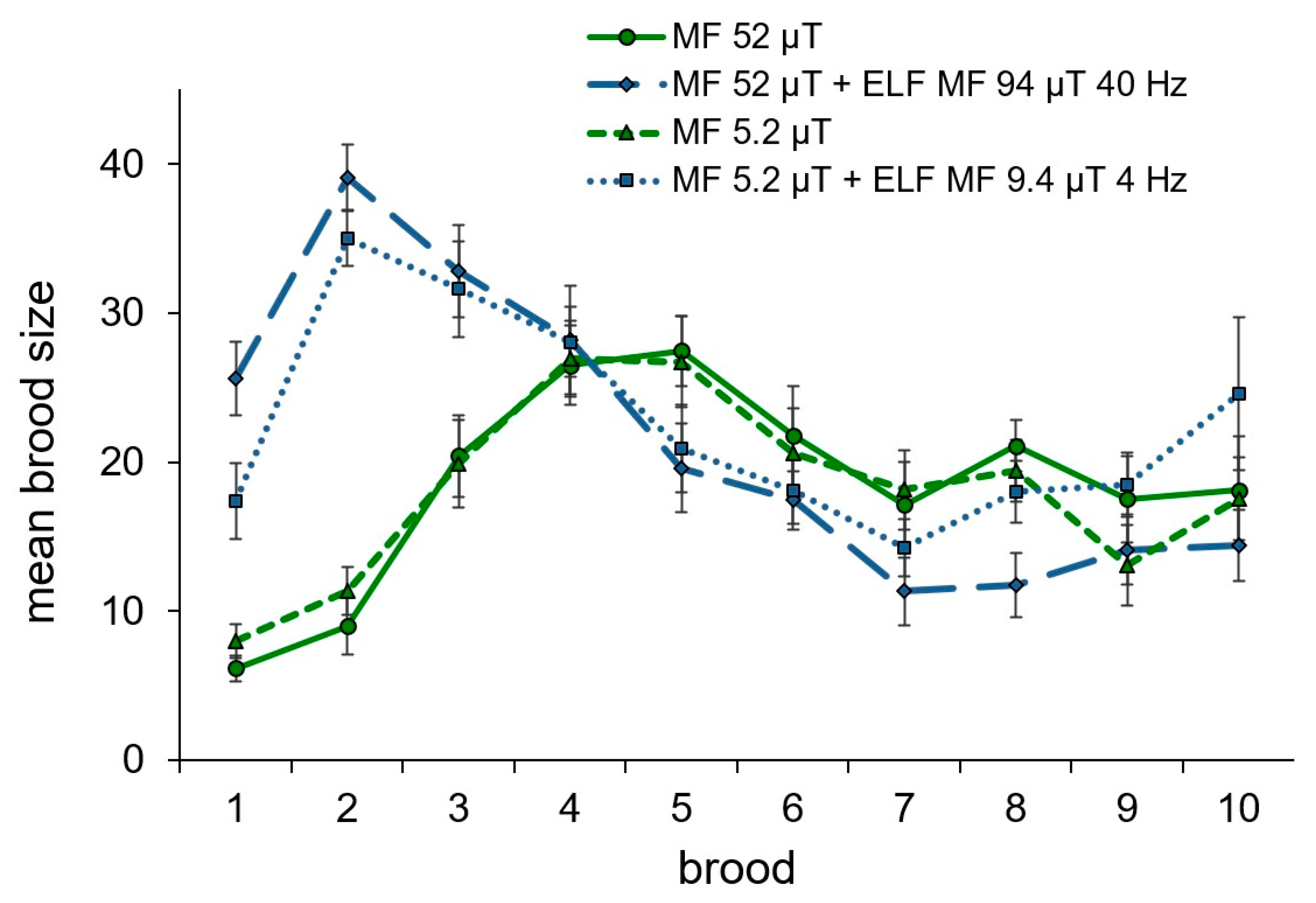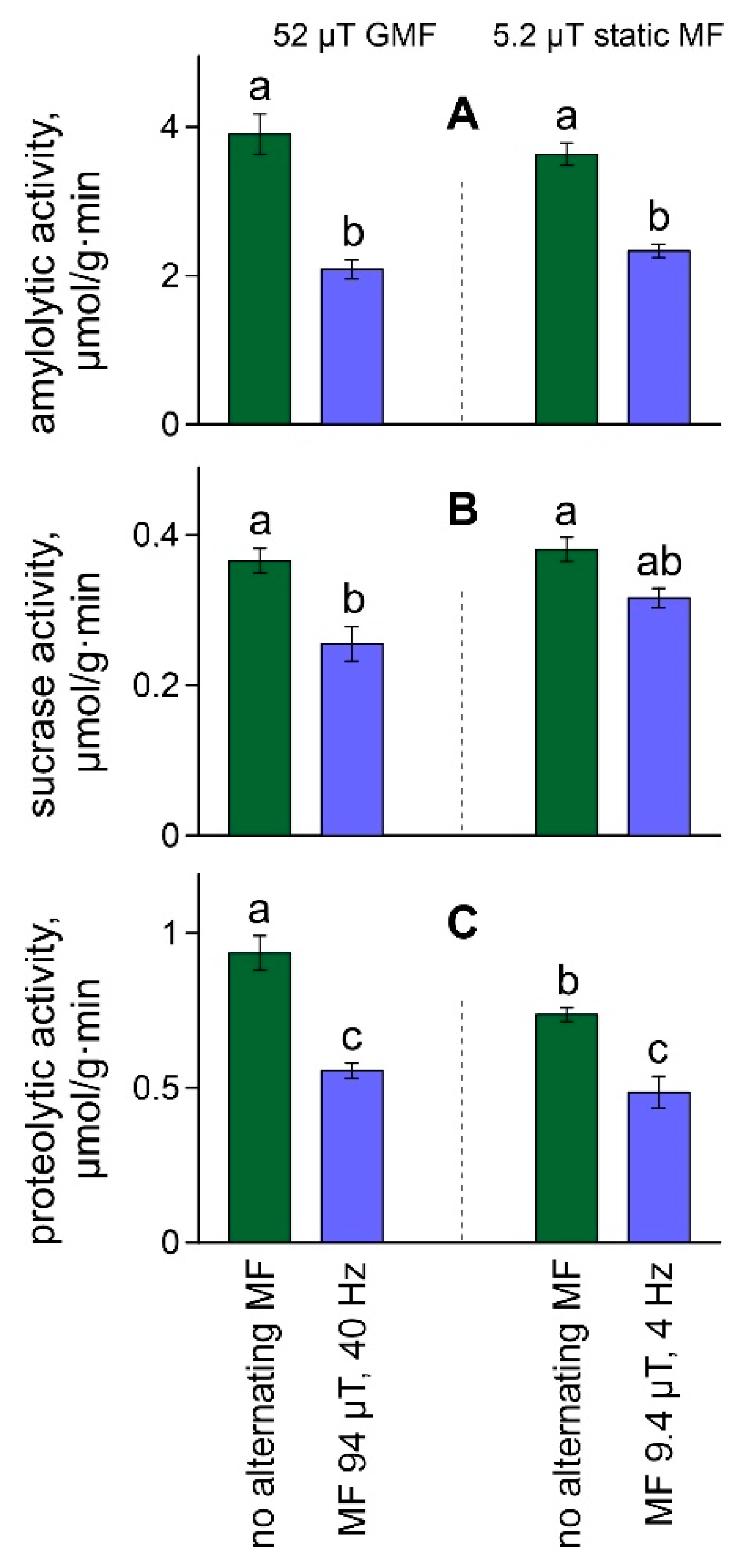Influence of Calcium Resonance-Tuned Low-Frequency Magnetic Fields on Daphnia magna
Abstract
1. Introduction
2. Results
3. Discussion
4. Materials and Methods
4.1. Test Animals
4.2. Magnetic Fields
- A 5.2 µT static magnetic field and a 9.4 µT 4 Hz alternating magnetic field;
- A 52 µT static magnetic field (the geomagnetic field) and a 94 µT 40 Hz alternating magnetic field.
4.3. Structure of the Experiments and Evaluated Parameters
- the geomagnetic field of 52 µT (control);
- ten-times reduced magnetic field of 5.2 µT;
- alternating magnetic field of 9.4 µT, 4 Hz combined with the reduced magnetic field of 5.2 µT;
- alternating magnetic field of 94 µT, 40 Hz combined with the geomagnetic field of 52 µT.
5. Conclusions
Supplementary Materials
Author Contributions
Funding
Institutional Review Board Statement
Informed Consent Statement
Data Availability Statement
Acknowledgments
Conflicts of Interest
References
- Magne, I.; Souques, M.; Courouve, L.; Duburcq, A.; Remy, E.; Cabanes, P.A. Exposure of adults to extremely low frequency magnetic field in France: Results of the EXPERS study. Radioprotection 2020, 4, 39–50. [Google Scholar] [CrossRef]
- Sarimov, R.; Binhi, V. Low-frequency magnetic fields in cars and office premises and the geomagnetic field variations. Bioelectromagnetics 2020, 4, 360–368. [Google Scholar] [CrossRef] [PubMed]
- Binhi, V.N.; Rubin, A.B. Magnetobiology: The kT paradox and possible solutions. Electromagn. Biol. Med. 2007, 4, 45–62. [Google Scholar] [CrossRef] [PubMed]
- Santini, M.T.; Rainaldi, G.; Indovina, P.L. Cellular effects of extremely low frequency (ELF) electromagnetic fields. Int. J. Radiat. Biol. 2009, 4, 294–313. [Google Scholar] [CrossRef]
- Wang, H.; Zhang, X. Magnetic fields and reactive oxygen species. Int. J. Mol. Sci. 2017, 4, 2175. [Google Scholar] [CrossRef]
- Klimek, A.; Rogalska, J. Extremely low-frequency magnetic field as a stress factor—Really detrimental?—Insight into literature from the last decade. Brain Sci. 2021, 4, 174. [Google Scholar] [CrossRef]
- Blackman, C.F.; Benane, S.G.; Rabinowitz, J.R.; House, D.E.; Joines, W.T. A role for the magnetic field in the radiation-induced efflux of calcium ions from brain tissue in vitro. Bioelectromagnetics 1985, 4, 327–337. [Google Scholar] [CrossRef]
- Smith, S.D.; McLeod, B.R.; Liboff, A.R.; Cooksey, K. Calcium cyclotron resonance and diatom mobility. Bioelectromagnetics 1987, 4, 215–227. [Google Scholar] [CrossRef]
- Ermakov, A.; Afanasyeva, V.; Ermakova, O.; Blagodatski, A.; Popov, A. Effect of weak alternating magnetic fields on planarian regeneration. Biochem. Biophys. Res. Commun. 2022, 4, 7–12. [Google Scholar] [CrossRef]
- Liboff, A.R. Geomagnetic cyclotron resonance in living cells. J. Biol. Phys. 1985, 4, 99–102. [Google Scholar] [CrossRef]
- Lednev, V.V. Possible mechanism for the influence of weak magnetic fields on biological systems. Bioelectromagnetics 1991, 4, 71–75. [Google Scholar] [CrossRef] [PubMed]
- Blanchard, J.P.; Blackman, C.F. Clarification and application of an ion parametric resonance model for magnetic field interactions with biological systems. Bioelectromagnetics 1994, 4, 217–238. [Google Scholar] [CrossRef] [PubMed]
- Prato, F.S.; Carson, J.J.L.; Ossenkopp, K.P.; Kavaliers, M. Possible mechanisms by which extremely low frequency magnetic fields affect opioid function. FASEB J. 1995, 4, 807–814. [Google Scholar] [CrossRef] [PubMed]
- Zhadin, M.; Barnes, F. Frequency and amplitude windows in the combined action of DC and low frequency AC magnetic fields on ion thermal motion in a macromolecule: Theoretical analysis. Bioelectromagnetics 2005, 4, 323–330. [Google Scholar] [CrossRef]
- Binhi, V.N.; Prato, F.S. A physical mechanism of magnetoreception: Extension and analysis. Bioelectromagnetics 2017, 4, 41–52. [Google Scholar] [CrossRef]
- Thomas, J.R.; Schrot, J.; Liboff, A.R. Low-intensity magnetic fields alter operant behavior in rats. Bioelectromagnetics 1986, 4, 349–357. [Google Scholar] [CrossRef]
- Picazo, M.L.; Vallejo, D.; Bardasano, J.L. An Introduction to the study of ELF magnetic field effects on white blood cells in mice. Electro. Magnetobiol. 1994, 4, 77–84. [Google Scholar] [CrossRef]
- Binhi, V.N. Magnetobiology: Underlying Physical Problems; Academic Press: London, UK, 2002. [Google Scholar]
- Belova, N.A.; Panchelyuga, V.A. Lednev’s model: Theory and experiment. Biophysics 2010, 4, 661–674. [Google Scholar] [CrossRef]
- Blackman, C.F.; Blanchard, J.P.; Benane, S.G.; House, D.E. Empirical test of an ion parametric resonance model for magnetic field interactions with PC-12 cells. Bioelectromagnetics 1994, 4, 239–260. [Google Scholar] [CrossRef]
- Baureus Koch, C.L.M.; Sommarin, M.; Persson, B.R.R.; Salford, L.G.; Eberhardt, J.L. Interaction between weak low frequency magnetic fields and cell membranes. Bioelectromagnetics 2003, 4, 395–402. [Google Scholar] [CrossRef]
- Sarimov, R.; Markova, E.; Johansson, F.; Jenssen, D.; Belyaev, I. Exposure to ELF magnetic field tuned to Zn inhibit growth of cancer cells. Bioelectromagnetics 2005, 4, 631–638. [Google Scholar] [CrossRef] [PubMed]
- Lednev, V.V.; Srebnitskaya, L.K.; Il’Yasova, Y.N.; Rozhdestvenskaya, S.Y.; Klimov, A.A.; Belova, N.A.; Tiras, K.P. Magnetic parametric resonance in biosystems: Experimental verification of the theoretical predictions with the use of regenerating planarians Dugesia tigrina as a test-system. Biophysics 1996, 4, 815–825. [Google Scholar]
- Prato, F.S.; Kavaliers, M.; Thomas, A.W. Extremely low frequency magnetic fields can either increase or decrease analgaesia in the land snail depending on field and light conditions. Bioelectromagnetics 2000, 4, 287–301. [Google Scholar] [CrossRef]
- Belova, N.A.; Potselueva, M.M.; Srebnitskaya, L.K.; Znobishcheva, A.V.; Lednev, V.V. The influence of weak magnetic fields on the production of the reactive oxygen species in peritoneal neutrophils of mice. Biophysics 2010, 4, 586–591. [Google Scholar] [CrossRef]
- Kantserova, N.P.; Ushakova, N.V.; Krylov, V.V.; Lysenko, L.A.; Nemova, N.N. Modulation of Ca2+-dependent protease activity in fish and invertebrates by weak low-frequency magnetic fields. Russ. J. Bioorg. Chem. 2013, 4, 373–377. [Google Scholar] [CrossRef]
- Kuz’mina, V.V.; Ushakova, N.V.; Krylov, V.V. The effect of magnetic fields on the activity of proteinases and glycosidases in the intestine of the crucian carp Carassius carassius. Biol. Bull. 2015, 4, 61–66. [Google Scholar]
- Tiras, H.P.; Petrova, O.N.; Myakisheva, S.N.; Popova, S.S.; Aslanidi, K.B. Effects of weak magnetic fields on different phases of planarian regeneration. Biophysics 2015, 4, 126–130. [Google Scholar] [CrossRef]
- Khokhlova, G.; Abashina, T.; Belova, N.; Panchelyuga, V.; Petrov, A.; Abreu, F.; Vainshtein, M. Effects of combined magnetic fields on bacteria Rhodospirillum rubrum VKM B-1621. Bioelectromagnetics 2018, 4, 485–490. [Google Scholar] [CrossRef]
- Trillo, M.A.; Ubeda, A.; Blanchard, J.P.; House, D.E.; Blackman, C.F. Magnetic fields at resonant conditions for the hydrogen ion affect neurite outgrowth in PC-12 cells: A test of the ion parametric resonance model. Bioelectromagnetics 1996, 4, 10–20. [Google Scholar] [CrossRef]
- Krylov, V.V. Impact of alternating electromagnetic field of ultralow and low frequencies upon survival, development, and production parameters in Daphnia magna Straus (Crustacea, Cladocera). Inland Water Biol. 2008, 4, 134–140. [Google Scholar] [CrossRef]
- Krylov, V.V.; Papchenkova, G.A.; Osipova, E.A. The influence of changes in magnetic variations and light-dark cycle on life-history traits of Daphnia magna. Bioelectromagnetics 2020, 4, 338–347. [Google Scholar] [CrossRef] [PubMed]
- Golovanova, I.L.; Filippov, A.A.; Chebotareva, Y.V.; Krylov, V.V. Long-term consequences of the effect of copper and an electromagnetic field on the size and weight parameters and activity of digestive glycosidases in underyearlings of roach Rutilus rutilus. Inland Water Biol. 2021, 4, 331–339. [Google Scholar] [CrossRef]
- Krylov, V.V.; Bolotovskaya, I.V.; Osipova, E.A. The response of European Daphnia magna Straus and Australian Daphnia carinata King to changes in geomagnetic field. Electromagn. Biol. Med. 2013, 4, 30–39. [Google Scholar] [CrossRef] [PubMed]
- Zaffagnini, F. Reproduction of Daphnia. Mem. Ist. Ital. Idrobiol. 1987, 4, 245–284. [Google Scholar]
- Krylov, V.V. Effects of electromagnetic fields on parthenogenic eggs of Daphnia magna Straus. Ecotoxicol. Environ. Saf. 2010, 4, 62–66. [Google Scholar] [CrossRef]
- Rochalska, M.; Grabowska, K. Influence of magnetic fields on the activity of enzymes: α- and β-amylase and glutation S-transferase (GST) in wheat plants. Int. Agrophys. 2007, 4, 185–188. [Google Scholar]
- Li, Y.; Ru, B.; Miao, W.; Zhang, K.; Han, L.; Ni, H.; Wu, H. Effects of extremely low frequency alternating-current magnetic fields on the growth performance and digestive enzyme activity of tilapia Oreochromis niloticus. Environ. Biol. Fishes 2015, 4, 337–343. [Google Scholar] [CrossRef]
- Golovanova, I.L.; Filippov, A.A.; Chebotareva, Y.V.; Izyumov, Y.G.; Krylov, V.V. Influence of hypomagnetic conditions on the activities of glycosidases and kinetic characteristics of carbohydrate hydrolysis in juvenile roach, Rutilus rutilus. J. Ichthyol. 2017, 4, 768–772. [Google Scholar] [CrossRef]
- Kantserova, N.P.; Krylov, V.V.; Lysenko, L.A.; Ushakova, N.V.; Nemova, N.N. Effects of hypomagnetic conditions and reversed geomagnetic field on calcium-dependent proteases of invertebrates and fish. Izv. Atmos. Ocean Phys. 2017, 4, 719–723. [Google Scholar] [CrossRef]
- Pinto, É.S.M.; Dorn, M.; Feltes, B.C. The tale of a versatile enzyme: Alpha-amylase evolution, structure, and potential biotechnological applications for the bioremediation of n-alkanes. Chemosphere 2020, 4, 126202. [Google Scholar] [CrossRef]
- Veillard, F.; Troxler, L.; Reichhart, J.M. Drosophila melanogaster clip-domain serine proteases: Structure, function and regulation. Biochimie 2016, 4, 255–269. [Google Scholar] [CrossRef] [PubMed]
- Zheng, J.; Zeng, X.; Wang, S. Calcium ion as cellular messenger. Sci. China Life Sci. 2015, 58, 1–5. [Google Scholar] [CrossRef] [PubMed]
- OECD. OECD Guideline for Testing of Chemicals, Test No. 202 Daphnia sp. Acute Immobilisation Test; Organization for Economic Cooperation and Development: Paris, France, 2004. [Google Scholar]
- ASTM. Standard Practice for Conducting Acute Toxicity Tests with Fishes, Macroinvertebrates and Amphibians; American Standards for Testing and Materials: Philadelphia, PA, USA, 1980. [Google Scholar]
- Ugolev, A.M.; Iezuitova, N.N. Determination of activity of invertase and other disaccharidases. In Study of the Digestive Apparatus in Humans; Ugolev, A.M., Ed.; Nauka: Leningrad, Russia, 1969; pp. 192–196. [Google Scholar]
- Anson, M. The estimation of pepsin, trypsin, papain and cathepsin with hemoglobin. J. Gen. Physiol. 1938, 4, 79–83. [Google Scholar] [CrossRef] [PubMed]



Publisher’s Note: MDPI stays neutral with regard to jurisdictional claims in published maps and institutional affiliations. |
© 2022 by the authors. Licensee MDPI, Basel, Switzerland. This article is an open access article distributed under the terms and conditions of the Creative Commons Attribution (CC BY) license (https://creativecommons.org/licenses/by/4.0/).
Share and Cite
Krylov, V.V.; Papchenkova, G.A.; Golovanova, I.L. Influence of Calcium Resonance-Tuned Low-Frequency Magnetic Fields on Daphnia magna. Int. J. Mol. Sci. 2022, 23, 15727. https://doi.org/10.3390/ijms232415727
Krylov VV, Papchenkova GA, Golovanova IL. Influence of Calcium Resonance-Tuned Low-Frequency Magnetic Fields on Daphnia magna. International Journal of Molecular Sciences. 2022; 23(24):15727. https://doi.org/10.3390/ijms232415727
Chicago/Turabian StyleKrylov, Viacheslav V., Galina A. Papchenkova, and Irina L. Golovanova. 2022. "Influence of Calcium Resonance-Tuned Low-Frequency Magnetic Fields on Daphnia magna" International Journal of Molecular Sciences 23, no. 24: 15727. https://doi.org/10.3390/ijms232415727
APA StyleKrylov, V. V., Papchenkova, G. A., & Golovanova, I. L. (2022). Influence of Calcium Resonance-Tuned Low-Frequency Magnetic Fields on Daphnia magna. International Journal of Molecular Sciences, 23(24), 15727. https://doi.org/10.3390/ijms232415727





